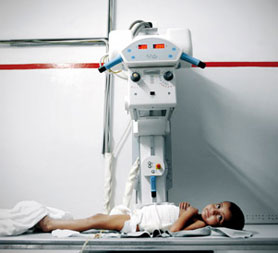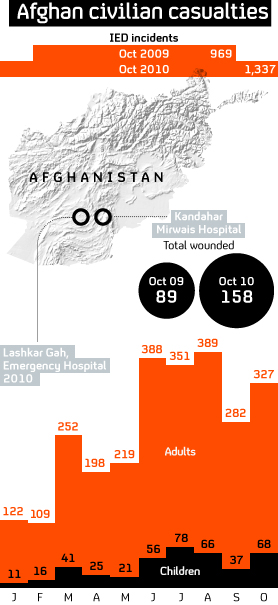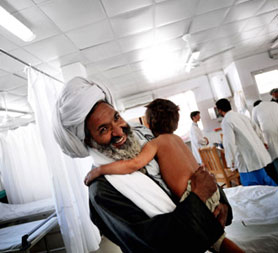Afghanistan: huge rise in war wounded civilians
The number of war wounded civilians in southern Afghanistan has increased dramatically this year following the military troop surge, an exclusive Channel 4 News investigation has found.

Thousands more patients are being admitted at one hospital in Kandahar alone – a threefold increase on the previous year in an area which has seen vicious fighting.
The number of children falling victim to the fighting has also risen dramatically.
In many cases civilians have lost limbs in explosions caused by improvised explosive devices or mine blasts while many others have suffered gunshot wounds or injuries caused by shelling.
Channel 4 News spoke to hospitals in the south of Afghanistan – areas where the Taliban is strongest, and where coalition forces are fighting hardest.
All of the hospitals said they were seeing major increases in war wounded civilians. One of the doctors, Matteo Dell’Aira, told Channel 4 News: “We have more war wounded than we have ever had in our six years of being here.”
– Mirwais Hospital, Kandahar – 163 per cent rise on number of war wounded civilians admitted in 10 months of 2010 to 3,056, compared to 1,159 in whole of 2009
– Emergency Hospital, Lashkar Gah – 89 war wounded civilians admitted in October 2009 – 158 admitted in October 2010, a rise of 77 per cent
– Military hospitals across Afghanistan – Minor rise in civilian casualties and “not surprising” to have more civilians than soldiers treated in its facilities on occasion
– Boost Hospital, Lashkar Gah – does not take in trauma patients for operations, although does take them in for post-operative care – but says civilians with other illnesses prevented from reaching them in time by war
This is backed up by figures from the United Nations mission on the war in Afghanistan. A report on civilian casualties released in summer by the UN showed that civilian deaths and injuries in the country had increased by 31 per cent year-on-year, to 3,268 in the first six months of 2010. The figures obtained by Channel 4 News on civilian injuries are even higher due to the intensity of the fighting in the south of the country – with injuries caused by war, according to our figures, up by between 77 per cent and 163 per cent.
The UN attributed 76 per cent of the incidents on insurgents – up from 53 per cent in 2009.
Deaths and injuries attributed to NATO and Afghan forces fell to 12 per cent.

Troop surge
In January this year, President Barack Obama sent in 34,000 more American troops to Afghanistan. A number of major operations have been launched this year in the south of the county – traditionally Taliban strongholds – including Operation Moshtarak in the Marjah area near Lashkar Gah in Helmand province, and Operation Hamkari in Kandahar.
The area has seen some of the bloodiest fighting since the war began with more than 100 British troops and 455 American soldiers killed in 2010 so far.
These numbers pale in comparison with civilian deaths in 2010. Afghanistan Rights Monitor said earlier this year that at least 1,000 civilians had died in the first six months of 2010.
More civilians wounded – Kandahar
In Kandahar, at the International Committee of the Red Cross (ICRC)-supported Mirwais Hospital, there has been a dramatic rise in the numbers of war wounded civilians in 2010.
From January to October this year, the numbers of civilians wounded in the war increased from 133 to 395 – almost tripling in the course of ten months. Injuries range from bullet wounds to limb loss caused by improvised explosive devices (IEDs)
In 2009, the hospital admitted 1,159 war wounded civilians over the entire 12-month period. So far in 2010, it has admitted 3,056 war wounded civilians in just the first 10 months of the year – already 163 per cent more than last year.
Head of the ICRC sub-delegation in southern Afghanistan, Markus Geisser, told Channel 4 News: “With the number of war-related injuries, you can clearly see that there is a sharp increase in the figures. There’s also the children.”
Read more: First hand stories from doctors working in the line of fire in Afghanistan
The numbers of children injured also increased over the year – from 11 war wounded children in January to 68 in October this year. This represents an increase of more than 500 per cent.

More civilians wounded – Lashkar Gah Emergency Hospital
In nearby Lashkar Gah, the story is the same.
Matteo Dell’Aira, the medical coordinator of the NGO-run Lashkar Gah surgical centre in Helmand province, told Channel 4 News: “We have more war wounded than we have ever had in our six years of being here.”
The statistics reveal a stark picture – in October last year, the hospital, run by Italian NGO Emergency, admitted 89 war wounded civilians. This year, it admitted 158 wounded adults and children – an increase of more than 77 per cent.
The children had an average age of six years old, Mr Dell’Aira estimated.
Read more: how does the military treat civilian casualties in Afghanistan?
The hospital has even changed its policy to cope with the numbers of war wounded people who come to their door.
Previously, as well as war wounded, the hospital also took in patients hurt in other ways – by car accidents, for example. However, it now only takes this kind of patient if they are aged under 14 years old.
More civilians wounded – military hospitals
Civilians are also admitted to military facilities in Afghanistan, which have a bed capacity of 400 across the country.
International Security Assistance Force (ISAF) medical commander Colonel Christopher Castle told Channel 4 News the military takes priority but they do no turn away anyone injured in the fighting, even suspected insurgents.
“We are in the business, in terms of taking care of local nationals, we’re saving life and limb,” he said.
The military does take in other civilian casualties on a discretionary basis, such as civilians injured in car accidents – but during operations they conserve space for predicted military casualties of war.
We are in the business, in terms of taking care of local nationals, we’re saving life and limb. ISAF medical commander Colonel Christopher Castle.
“If there’s an operation, for example around Hamkari, bed space around Kandahar is at a premium,” said Colonel Castle.
“We’ll do what we can to evacuate patients to other facilities. But the system is rarely running at capacity – and no one in urgent need of care is refused.
“I’m not sure I’m ready to say that on any day 50 per cent of our beds are occupied by locals, but it wouldn’t surprise me.”

When the military facilities are full, civilians are transferred to local and NGO-run hospitals because rehabilitation is a “local responsibility”, said Colonel Castle. Around 110 civilians are transferred every month.
“We save their lives and that’s a good thing,” he said.
“What we’re trying to do is apply the resources we have in the most effective way to get the best overall health outcome for the population,” he said.
“That definitely doesn’t mean that an Afghan civilian released from our hospital is being released to a Western standard of care – that’s just not possible and won’t be for a decade. But we’re making progress…the numbers are bleak but they are getting better.”
More civilians wounded – Lashkar Gah Boost Hospital
Staff at all of the hospitals said that the war also caused “indirect” casualties which affected the poor Afghan communities they serve.
The health system in Afghanistan has been decimated after thirty years of war, with poverty and malnutrition also major issues.
ISAF medical commander Colonel Christopher Castle told Channel 4 News: “I want people to understand the context all this happens in, and remember who the bad guy is.
“It’s happening in the context of a dilapidated healthcare system. So anything we can do to alleviate the suffering is better than it started.”
The continuing conflict also makes it dangerous to travel, meaning patients often arrive at the hospitals too late for the doctors to do anything to help them.
There is no such thing as a nice war wound…but the biggest danger is for Afghans travelling any distance to get here. Medecins Sans Frontieres Afghanistan representative, Michiel Hoffman.
The Boost Hospital is next to the Emergency trauma hospital in Lashkar Gah. It does not take in trauma patients for surgery as a norm, although it does take them in for post-operative care. It focuses on general healthcare, including maternity services.
The Boost Hospital is supported by Medecins Sans Frontieres. Its country representative, Michiel Hoffman, told Channel 4 News that the biggest danger for Afghans was how long it took them to get to the hospital for treatment as a result of having to avoid the fighting.
“There is no such thing as a nice war wound,” he said. “Even the simplest weapon has devastating medical consequences. But the biggest danger is for Afghans travelling any distance to get here. The biggest problem is them arriving late in terms of their disease.
“So a two hour peace-time journey could take two or three days as they go around the checkpoints, with the result that the disease has progressed much more seriously to life threatening in some cases…We hear lots about how dangerous it is for doctors, but the biggest danger is for the poor farmer with the sick child.”

Christian Schuh, a German paediatric nurse at the Mirwais in Kandahar, agreed.
“In our situation, sometimes the [children] arrive after five days or seven days because of the situation we are working in and they are living in here.
“And then sometimes there is nothing any more that you can do for those patients because they are in really severe respiratory distress…those patients die because of the lack of access to healthcare.”
Read more: why is it getting worse for civilians in Afghanistan?
But for Afghan civilians, the major danger continues to be the risk of getting caught up in the fighting in their country, a risk which is vividly illustrated by Matteo Dell’Aira’s description of a day in his hospital.
“We see lots of injuries caused by mines, bullets. Shell injuries.
“There are lots of losses of limbs – we are full of amputees and people who need prosthetics. But it changes every week. For example, last week we had to amputate three limbs on the same person – one arm and two legs. We obviously do our best but he came after I don’t know how many hours and had lost a lot of blood. We lost him after two to three days.”
Channel 4 News visited Mirwais Hospital in Kandahar in summer 2009. Watch the report below.
All images on this page were provided by Emergency, and were taken in its Lashkar Gah hospital.